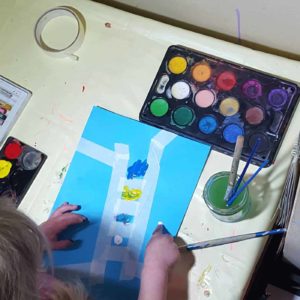
A little post in response to Kate Mitchell’s question on Facebook
Offering spiritual play opportunities is something a little different from our usual tell a Bible story and do Thanks / Sorry / Please prayers. It involves more trust – trust in the methodology, in our children and, of course, in God!
An easy way to do it is to use the Godly Play model and adapt it for your home. When I do this I will choose 3-5 activities for the response time and set them out invitingly on a mat, tray, table or tough spot before we start. I then ask my children if they’re ready for the story which gives them chance to opt in (or out!) – I find chosen activities are much easier to keep attention. A good way to choose what to put out is to think about what they enjoy using, think variety, and think about novelty. I might put out something to build things (construction toys such as Lego or stickle bricks, wooden blocks or magnetics), something for role play or small world play (e.g. play cloths or little wooden wired-legged people), something to make art including something to make a ‘piece’ (e.g. canvas board and Sharpies) and something to do process art (where it all gets put away at the end) (e.g. shells, stones and lollysticks). I try to bring out something we’ve not used for a while (today it was chalk) as well as something they’re currently loving (today that was Lego). This sounds like a lot of work, but it only takes about 2 minutes to set up once you’ve worked out what you’re going to put out.
When I was asked this on Facebook by Kate, I asked her what her children are into and she said:
My 4 year old likes Lego, toy cars, anything that goes fast and he loves stories. The 2 year old likes putting things in bags and boxes, and dogs! They both love baths and messy play.
In that case, I’d suggest sharing a story using Lego – make a set or use the models to share the story together. Or just put it out in an inviting way to respond after you tell the story.
What about using cars or dogs as characters in a Bible story (think Simon Peter as Rocky from Paw Patrol!)?
Could you have a story sack and give them a box in which to place each item, one box for them all or lots of little boxes?
Can you tell a quick 2 minute story in the bath then use plastic toys (e.g. Duplo) or other plastic items for playing afterwards?
How about using two vehicles and labelling one The Train (or truck) of Joy and the other The Bus of Peace, then allocate play people as friends and family and ask the child which do they think this person needs most today, what can we ask God to give them: lots of Joy or lots of Peace? They then add that character to the appropriate vehicle and off you go. You could do a few people or just one. You could also let them know you’ve prayed for them today, and what your child chose to ask God to give them. I’ve been happily amazed at how spot-on they can be.
Play dough can be made nice a sticky just by adding various elements or just more water. I once made one with jelly. That was very sticky. This could be the ‘scene’ for any Bible story, with plastic people ‘wading’ through it as they act out the story. Very gooey!
I often share the story using a Godly Play script, but sometimes I read a story from the Bible (CEV works will even with young children) or a Bible story book. I try and keep the pace slow, and ask wondering questions at the end: I wonder what you liked best. I wonder which is the most important part of this story. Then I invite them to choose what they’d like to do next. If I’ve used things to share the story, they often use these to re-tell their own version. Then they move onto the response materials. Sometimes this lasts for ages, sometimes only a few minutes. I don’t mind. Often they mix the materials I’ve used to tell the story with materials from other stories. Sometimes they come back to their ‘work’ on another day. Sometimes they request a certain story. That’s always interesting.
What I’ve found from employing this technique or methodology is that it allows them space to play and develop their own theology, or thinking about God, which is exactly what I want them to do – to own their faith and to develop their own links within the Bible and from the Bible to their lives. Sometimes they say profound things, other times they don’t. The times when they do allow my to have confidence that there’s deep work going on and that they are connecting with God as they play.
Will you be bold and give it a go?
